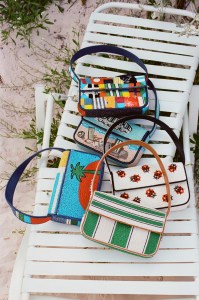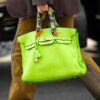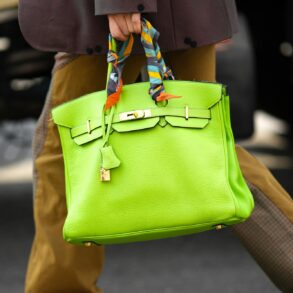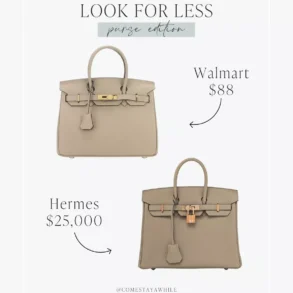The handbag category has softened over recent years as economic pressures and other factors have sparked large price increases among luxury brands and have caused customers to cut back on spending. Despite the challenges of the category, industry experts are seeing a bright spot in the market: contemporary handbag brands.
In the last year, interest among customers in contemporary handbag brands has skyrocketed as many are looking at more affordable options from labels that can be just as well-known as their luxury competitors. Price point is the leading driver in this growing popularity, with most labels offering styles under $1,000. Data shows there’s a wide range of brands that are resonating with consumers.
According to London-based shopping platform Lyst, brands like Turkish label Manu Atelier have increased in demand by 117 percent in the last quarter — with searches for its shoulder bag up 64 percent month-to-month — and British label DeMellier London saw an increase of 119 percent last quarter, with its New York leather tote bag up in searches by 153 percent month-to-month, its Tokyo suede shoulder bag up 362 percent week-to-week and its Vancouver leather bag up 521 percent month-to-month.
You May Also Like
In the U.S., 11-year-old accessories label Mansur Gavriel is having a resurgence, with Lyst data showing demand for its Mini Cloud Clutch growing by 992 percent last quarter, its Gaia shoulder bag growing by 311 percent month-to-month and its Candy hobo bag increasing by 90 percent month-to-month.

A DeMellier London New York bag
DeMellier leather handbags
“The competition is coming from a lot of different ways in this market,” said Beth Goldstein, executive director and industry analyst of accessories and footwear at Circana. “Consumer priorities have changed in terms of the importance of the category, especially in the last few years where wallets definitely have become tough. Coming out of the pandemic, there was a lot of savings — it was all about stimulus — and the designer business had a really good year and a really strong 2021 and 2022, and has since really fallen off.”
Aside from price point, innovation and design are other factors contributing to contemporary brands’ popularity. While luxury houses tend to rely on their icons, contemporary labels are able to respond more quickly to industry trends and customer preferences to deliver newness.
“They can move quickly, they can be nimble and they have the ability to be more playful on social [media],” said Karen Gibson, president of the Accessories Council. “They don’t have corporate rules necessarily. I’m a big fan of the luxury brands and there’s a foundation to them that will be there, and we’re always going to want and admire those brands and have them in our wardrobes, but I think there is a playful way to add some of the other contemporary brands.”
Growth in contemporary handbag brands can also be attributed to the increased popularity of novelty bags in the last year, where many customers swapped their traditional black or brown leather options for more playful and graphic styles. As part of this trend, fashion brands like Staud, Cult Gaia and Susan Alexandra, among others, have reigned.

An array of Staud Tommy bags.
Courtesy of Staud
“What I am seeing is exceptional novelty bags that draw you in,” Gibson said. “To some degree brands like Staud and Alexis Bittar, they all have something that’s novel and fun that sucks you in, and then what you end up buying is something maybe more practical, but those novelty bags I think are doing quite well.”
Department stores are also seeing this impact. At Nordstrom, specifically, the retailer said customers are gravitating toward contemporary labels they’re familiar with on the apparel side, such as Veronica Beard and Staud.
“Our customers seek high-quality bags with excellent design, and contemporary handbag brands deliver just that,” said Debbi Hartley-Triesch, executive vice president and general merchandise manager of beauty, accessories and home at Nordstrom. “These brands use premium materials without compromising on quality. They offer timeless, classic handbags as well as trendy, seasonal options. Contemporary handbags are more accessible, providing high-end style at a more affordable price point.”
Both Gibson and Goldstein also noted that functionality and practicality have become important factors for customers purchasing their handbags. While on the lower end of the price spectrum, both experts highlighted the viral popularity of Uniqlo’s nylon shoulder bag priced at $14.90, Lululemon’s Everywhere Belt Bag priced at $38 and Trader Joe’s mini canvas tote bags priced at $2.99 as indications that function is just as important as design for customers.
“Why some of these lower price point bags are winning is just the idea that really the function has become super important just to everybody’s busy lifestyles,” Goldstein said. “You’re starting to see that come into play a little bit more and the contemporary space doesn’t necessarily have more or less of this. But I think it’s why overall the handbag space is struggling because other things are coming in that are providing more function and practicality to consumers.”
While the range in prices in the contemporary market is vast and isn’t on the level of luxury houses, the innovation, quality, design and functionality these contemporary handbag brands present make them a strong player in the overall category that should not be ignored.
“The contemporary space is still a smaller piece of [the handbag category] compared to the designer piece,” Goldstein said. “Then the bridge market — like your Coaches, your Michael Kors, Kate Spade and Tory Burch — that’s like the biggest meat of this market, but that’s been struggling. Not all of them — there are some brand highlights within that as well — but the designer space has definitely lost share over the last five years and contemporary has gained a little bit.”
This post was originally published on this site be sure to check out more of their content.







